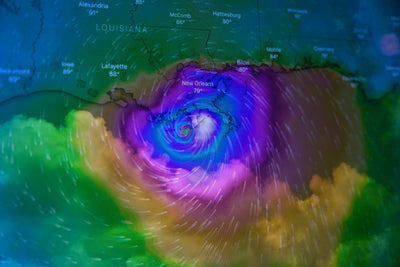Introduction
Dogs, like people, can feel dizzy and uncomfortable when riding in the car. As a dog owner, it is inevitable that your heart will be torn when you see your fur child showing a difficult expression in the car. Dogs motion sickness symptoms are varied, from the state of mind to the body reaction, and then some subtle behavioral changes, each of which may be a signal that they are asking for your help. Next, let's go into the world of dogs, learn how they behave when they get motion sickness, and explore how to help them relieve their discomfort through medication and other means.
Symptoms for Motion Sickness in Dogs
1. What does your dog's mental state tell you when he gets motion sickness?
Have you ever noticed that every time you take your dog out in the car, its lively energy seems to disappear all of a sudden? Some dogs become lethargic when they get into the car, lazily lying on the seat with dull eyes, as if they are not interested in everything around them. This is in stark contrast to the way they bounce around at home, and makes you want to ask, “Baby, what's wrong with you?”

Still other dogs are the opposite; they become irritable, fidgeting in the car, moving around, and even making slight grunts or wails, as if telling you in their own way, “I'm really uncomfortable!” Other dogs will choose to be silent, and they will lie down in the car unusually quietly, not moving at all, as if they are holding something back. This quietness is not relaxation, but a sign that they are not feeling well. As owners, we have to learn to read these subtle signals in order to lend a helping hand in time.
2. Physical reaction: from vomiting to rigid distress signals
In addition to changes in mental state, the dog's physical reaction to motion sickness is often more intuitive, but also more upsetting. Vomiting can be one of the most common symptoms. Imagine that the car hasn't been driving for long, and your dog suddenly starts to dry-heave, followed by vomiting up some food scraps or even yellow bile, with drool or even white foam hanging from the corners of their mouth. What owner can look at them in pain and not feel heartbroken?
Even if there is no vomiting, the dog may drool and drool. The drool drips down from the corners of their mouths, sometimes with thick foam, letting people know at a glance that they are not feeling well. Other dogs will be short of breath, panting as if they've run several laps, as if they're trying to feel better. If the motion sickness worsens, you may notice that your dog's body gradually becomes stiff and their muscles tighten, as if the whole dog is freezing. These physical reactions are the dog's way of telling you: “Master, I need help!”
3. Behavioral manifestations: the discomfort behind subtle actions
In addition to the obvious mental and physical changes, some of the small actions of the dog when he is carsick are also worthy of our attention. For example, you may find your dog licking their lips constantly, as if they are relieving some kind of discomfort. They may also yawn frequently, but it's not because they're sleepy, it's that they're trying to adjust to the imbalance in their inner ear by taking deep breaths.
More interestingly, many dogs will try to poke their heads out the window. They are not simply trying to see the view, but because fresh air makes them feel better. These behaviors, while subtle, are instinctive responses of dogs as they try to combat motion sickness. Attentive owners may want to pay more attention to these small details and create a more comfortable environment for their dogs in a timely manner.
4. Severe cases: an alarm that cannot be ignored
If your dog's motion sickness is particularly severe, the situation may become more difficult. Some dogs may become incontinent as a result of the discomfort, which is not only embarrassing for them, but also for the atmosphere in the car. More rarely, but more dangerously, a very small number of dogs with severe car sickness may even pass out. At such times, the owner's heart is afraid to be in his throat.
Once you notice these serious symptoms in your dog, don't panic. Rush to find a safe place to park, take the dog out and lie down flat to keep it breathing smoothly, and then contact a veterinarian for professional help as soon as possible. After all, your dog's health and safety always comes first.
After learning about all the signs of car sickness in dogs, what can we do to help them? In addition to daily calming and preparation, medication can sometimes be an effective option. However, before using medication, always consult your veterinarian to ensure safety and suitability.
For dogs that frequently get carsick, your veterinarian may recommend some anti-motion sickness medications, such as cetirizine or maropitant. These medications can help relieve nausea and vomiting and make your dog comfortable during the trip. However, every dog has a different constitution, and the dosage and usage must strictly follow your veterinarian's instructions, rather than giving the medication on your own.
Give the medication in advance: you usually need to give your dog the medication 30 minutes to 1 hour before departure to give the medication enough time to take effect.
Cooperate with an empty stomach: Try to keep your dog on an empty stomach before taking the medication, as this will minimize vomiting as well as allow the medication to be better absorbed.
Observe the reaction: After the first dose, pay attention to the dog's state to see if there are any side effects, such as drowsiness or abnormal excitement.
Drugs alone are not enough, owners can also match some small tricks. For example, put a soft cushion in the car, so that the dog has a comfortable nest; open the windows at the right time to give them fresh air; or softly soothing, touch their heads, so that they feel your company. These small gestures can often make the effect of the drug twice as effective.
Medication for Motion Sickness in Dogs
Dogs are our faithful companions, whether it's a short drive or a long trip, we want them to enjoy the journey as much as we do. However, some dogs can suffer from motion sickness, vomiting, drooling, and restlessness...... These symptoms are heartbreaking for their owners. Fortunately, there are some medications that can help alleviate the symptoms of motion sickness in dogs, so that they can also be peaceful and comfortable in the car. Next, let's learn more about these little car sickness helpers and how to use them safely and correctly.

1. Antihistamines
Antihistamines are a common choice for relieving motion sickness in dogs. They work by regulating the nervous system and blocking the signals that make your dog feel dizzy and nauseous, both preventing the symptoms and making your dog feel more relaxed during the trip.
Tea Phenhydramine
This medication acts like a gentle guardian, calming your dog's nerves and reducing feelings of dizziness and vomiting. It also has some calming effects, making it especially good for dogs who tend to get nervous in the car. It is usually given to your dog 30 to 60 minutes before departure and can be given again every 4 hours, up to 4 to 6 times a day. Imagine the scenery flying by outside the window, your dog curled up in the seat, snoozing peacefully, and the discomfort of motion sickness long gone.
Diphenhydramine
Another antihistamine with equally reliable results. It is recommended that you give it to your dog an hour before you leave; it is absorbed quickly and takes effect in 30 minutes. Whether it's for a short or long distance, it can quickly help your dog get rid of motion sickness.
Meclozine
If you want your dog to stay awake and unaffected by drowsiness while traveling, Meclozine is a good choice. It is a non-sedating antihistamine with mild side effects, and one dose an hour before departure is enough for one day. The dog can enjoy the journey without worrying about dizziness and nausea.
2. Anticholinergics
Anticholinergics, on the other hand, are hardcore players tailor-made for long-distance travel. They combat motion sickness by decreasing parasympathetic excitability and have a long-lasting effect, making them suitable for dogs that need to take long car rides.
Scopolamine
Here's a special thing about this medication - it's available in patch form. Simply apply the patch to the dry, hairless skin behind one of your dog's ears before you leave, and it will begin to work in 4 hours, with the effects lasting for 2 to 3 days, making it a godsend for long-distance travel. However, remember to remove the patch after the trip so that it doesn't last too long and affect your dog's normal condition.
Phencyclidine
Similar to scopolamine, benzocyclononate is also a slow burner with a slow onset but long duration of action. Give your dog a dose half an hour before you leave, and if the trip is particularly long, you can get another dose 4 to 5 hours later. It provides long-lasting protection for owners who like to take their dogs on driving trips or boat rides.
3. Other medications
In addition to antihistamines and anticholinergics, there are a number of other medications that can provide help for your dog's motion sickness symptoms.
Difenidol
This medication regulates your dog's vestibular nervous system, blocks vertigo signals, and also suppresses the feeling of vomiting. By giving your dog one to two tablets orally 30 minutes before departure, three times a day, the dizziness and nausea associated with motion sickness can be greatly relieved. When riding in the car, your dog no longer needs to curl up in a corner and shiver, but can look out the window curiously and enjoy the scenery of the journey.
Calcium antagonists
Such as cinnarizine or flunarizine hydrochloride, these medications improve blood flow to your dog's brain and help the brain adapt better to the shaking of the car. However, they are mainly used to prevent vertigo or migraines, and are generally effective if used for motion sickness, and the side effects of drowsiness and fatigue are more pronounced, so they are less recommended as a first choice.
4. Compounding
If you're looking to relieve multiple discomforts in your dog with one medication at the same time, compounded preparations may be right up your alley. For example, ANERON NYSCAPS, which combines antihistamines, scopolamine, vitamin B6, caffeine, and gastric mucosal anesthetics, can relieve dizziness as well as calm a churning stomach. Give your dog a single dose 30 minutes before departure for a long-lasting medication that will keep your dog comfortable and enjoying the ride all day long.
While medication can help dogs with motion sickness, safety always comes first. Here are a few things that owners must keep in mind:
Some dogs may not be suitable for motion sickness medication, such as dogs that are too young (usually dogs under 6 years old have incomplete neurological development), pregnant bitches, or dogs with glaucoma. If your dog falls into any of these categories, it's best to consult your veterinarian first and not rush into medication.
Some motion sickness medications can make your dog sleepy and unfocused, so if your dog needs to stay alert while traveling (such as for an event or competition), it's best to choose a medication with milder side effects.
Motion sickness medication should not be mixed with other medications, such as cold remedies, anti-allergy medications, tranquilizers, cough suppressants, expectorants, etc. Don't use it with gastrointestinal pain relievers, as it may cause adverse reactions. Be sure to read the instructions carefully before using the medication, or consult your veterinarian to ensure safety.

Although it is heartbreaking for dogs to get carsick, as long as we prepare with care and use medication scientifically, we can make them suffer less. From antihistamines to anticholinergics to compounded preparations, every drug has its place. Of course, in addition to medication, the owner's gentle soothing and attentive care is equally important.
Summary
While medications can help dogs with motion sickness, safety always comes first. Here are some points that owners must keep in mind.
Some dogs may not be suitable for motion sickness medication, such as dogs that are too young (usually dogs under 6 years of age have incomplete neurological development), pregnant bitches, or dogs with glaucoma. If your dog falls into any of these categories, it is best to consult your veterinarian first and not rush into medication.
Some motion sickness medications can make your dog drowsy and unfocused, so if your dog needs to be alert while traveling (for example, to participate in an event or competition), it's best to choose a medication with fewer side effects.
Motion sickness medication should not be mixed with other medications, such as cold remedies, anti-allergy medications, tranquilizers, cough suppressants, and expectorants. It should also not be used together with gastrointestinal painkillers to avoid causing adverse reactions. Always read the instructions carefully before using the medication or consult your veterinarian to ensure safety.
Dog motion sickness is certainly heartbreaking, but as long as we are carefully prepared, scientific use of medication, you can let them suffer less. From antihistamines to anticholinergics to compounded preparations, every drug has its place. Of course, in addition to medication, the owner's gentle soothing and attentive care is equally important.





